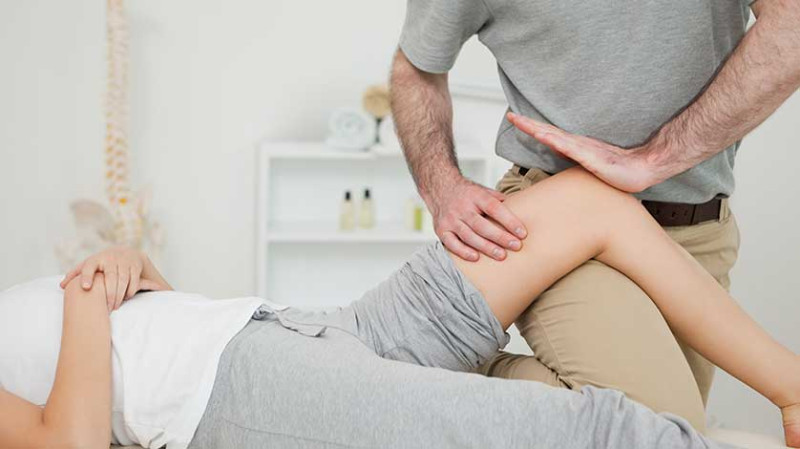
Whether you're a DIY enthusiast renovating a Victorian terrace, a young professional clocking long hours at your desk, a tradesperson with a physically demanding job, or an interior designer constantly on the move, back pain can be a daily reality. One of the most commonly affected areas of the spine is the lumbar region, particularly the L5/S1 segment. This is where the fifth lumbar vertebra meets the first sacral vertebra. It's a common pain point, but thankfully, one that can often be treated effectively with spinal manipulation performed by osteopaths, chiropractors, or other trained professionals.
If you're experiencing lower back pain or stiffness, especially near your waist or pelvis, it may be time to explore whether a lumbar manipulation could offer relief. In this post, we explore what spinal manipulation is, how the L5/S1 adjustment works, and what you can expect before, during, and after treatment.
What Is Spinal Manipulation?
Spinal manipulation refers to a hands-on treatment technique applied to joints of the spine, typically to relieve pressure, improve function, and restore range of motion. Techniques may vary slightly depending on whether the practitioner is a chiropractor, osteopath, or physiotherapist, but the overall goal is the same: realign the spinal joints and reduce inflammation or nerve irritation.
This practice dates back centuries and is rooted in both osteopathic and chiropractic traditions. Today, it is widely recognised and supported by growing evidence for helping with lower back pain, especially in patients who have not responded to medication or physical therapy alone.
In the context of the lumbar spine (lower back), manipulation typically targets segments that are prone to compression or instability, namely, the L4/L5 and L5/S1 joints. These are the transition zones between your spine and your pelvis, and they're under constant motion and pressure, especially with activities common in trades or home renovation work such as lifting, bending, or twisting.
Why Is the L5/S1 Spinal Segment So Important?
The L5/S1 vertebrae mark the end of your lumbar spine and the beginning of your sacrum. This area bears a significant amount of mechanical stress from movement, making it especially vulnerable to injury, slipped discs, or nerve impingement (often felt as sciatica).
This joint plays a critical role in pelvic stability, core support, and the flexibility of your lower back. People who sit for extended periods (like architects working at CAD stations), stand all day (tradespeople or decorators), or frequently bend and lift (DIY and manual labourers) are at higher risk for dysfunction here.
When something is "off" at L5/S1, you might experience localised pain, stiffness, nerve symptoms like tingling down one leg, or reduced strength in your lower body. A proper diagnosis and targeted spinal manipulation can often make a significant difference in your recovery and comfort.
How Does a Lumbar Manipulation Work?
A spinal manipulation procedure at the L5/S1 joint typically involves a practitioner using specific manual techniques to apply a thrust to the affected joint. This helps reset joint mobility, reduces nerve pressure, and allows surrounding tissues to begin healing. You might hear a 'click' or 'pop' during the adjustment, this is simply gas being released from the joint, much like cracking your knuckles.
Before any adjustment, your practitioner (whether a chiropractor, osteopath, or physiotherapist with relevant training) will assess your posture, range of motion, muscle tension, and spinal alignment. They'll likely take a detailed history and may refer for imaging, like X-rays or MRIs if there's a suspicion of serious disc issues or underlying pathology.
The manipulation itself usually lasts just a few seconds, though you may have some preparatory mobilisation or soft tissue massage done beforehand. No special preparation is needed on your part, although wearing comfortable clothing and staying hydrated is recommended.
Benefits of L5/S1 Adjustment
Adjusting the L5/S1 vertebra can offer a range of benefits, especially for people dealing with repetitive strain, sciatic pain, or mobility issues caused by sedentary work or physically demanding jobs.
- Immediate or gradual reduction in lower back pain
- Relief of nerve symptoms (e.g., numbness or tingling in the legs)
- Improved posture and spinal alignment
- Increased range of motion and flexibility
- Enhanced spinal stability and improved muscle engagement
- Quicker return to daily activities, work or training
While not everyone experiences instant results, many report feeling "lighter" and more mobile after even one session. Multiple treatments may be recommended depending on the underlying condition and occupational habits.
What to Expect After Treatment
After a spinal manipulation, it's normal to feel soreness for a day or two, similar to how you feel after a workout. This is due to the realignment of the joints and activation of supportive muscles.
Your practitioner may advise you to avoid heavy lifting or sudden movements for 24-48 hours and encourage light walking or stretching to maintain mobility. In some cases, they'll offer exercises to strengthen your core and support the spine.
In most instances, recovery is swift, and patients report a significant reduction in pain and improvement in their ability to return to work or hobbies. Tradespeople often say they can lift better, while office workers notice less stiffness during long sitting sessions.
When Should You See a Professional?
If you're dealing with persistent lower back pain, shooting pains down your leg (sciatica), stiffness in your hips or pelvis, or numbness, especially after lifting, twisting or prolonged sitting, it's worth booking a consultation. An assessment can determine whether the pain is due to joint dysfunction, muscle tension, or something more serious like a herniated disc.
Many UK practitioners are covered by insurance providers, and some offer introductory sessions. Look for qualified osteopaths (registered with the General Osteopathic Council) or chiropractors (registered with the General Chiropractic Council) to ensure you're in safe hands.
Final Thoughts
Lower back pain, particularly around the L5/S1 area, affects a wide cross-section of the UK population, from young professionals working remotely to tradespeople tackling physical demands daily. With spinal manipulation, particularly when performed by qualified osteopaths or chiropractors, lasting relief and better spinal health are within reach.
If you're tired of taking painkillers or avoiding certain movements, lumbar manipulation might offer a powerful and safe alternative. As always, pair any manual therapy with a proactive approach to ergonomics, movement, and exercise for long-term results.



